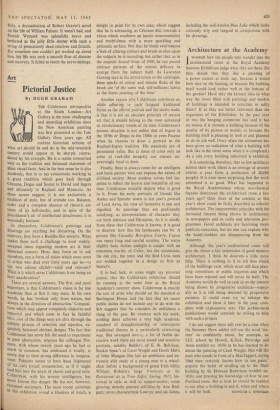Art
Pictorial Justice
By HUGH GRAHAM THE Coldstream retrospective at the South London ■ Art Gallery is the most challenging and unsettling exhibition since the New American painting was first presented at the, Tate Gallery three years ago. All current historical notions of What art should be and do in the mid-twentieth century would appear to be sharply contra- dicted by his example. He is a realist committed Only to the truthful and balanced statement of plain visual facts. And in the best sense he is also academic, that is to say consciously working in a great tradition which goes back through Cezanne, Degas and Seurat to David and Ingres and ultimately to Raphael and Masaccio. As these names suggest, it is not exclusively a tradition of style, but of attitude too. Balance, order and a complete absence of rhetoric are some of its hall-marks, and in spite of the practitioner's air of intellectual detachment, it is essentially humane.
In themselves, Coldstream's paintings and drawings are anything but disturbing. On the contrary, they have a Buddha-like serenity. What makes them such a challenge to most widely- accepted ideas regarding modern art it their historical context. How, they force us to ask ourselves, can a form of vision which owes most to artists who died over forty years ago beto use two odious clichés—valid and relevant? What is it which saves Coldstream from being an inert anachronism?
There are several answers. The first, and most important, is that Coldstream's vision is far less academic than at first it may seem. In his own words, he has `worked only from nature, but always in the direction of abstraction.' Composi- tions which may appear completely objective and impartial and which must in fact be faithful likenzsses of the things seen are also, through the subtlest process of selection and rejection, ex- quisitely balanced abstract designs. The fact that Coldstream has never felt the need to experiment to pure abstraction, whereas his colleague Pas- more, with whom twenty years ago he had so much in common, has embraced it totally, is surely due to their strong difference in tempera- ment. PaSmore seems to have been frightened of his own lyrical romanticism, as if it might lead him into the abyss of charm and good taste. Coldstream, with his severer intelligence, has never known this danger. He has not, however, remained stationary. The most recent paintings in this exhibition reveal a ffeedom of touch, a delight in paint for its own sake, which suggest that he is advancing, as Cdzanne did, towards a vision which combines an innate monumentality and truthfulness with a more sparkling and prismatic surface. Not that he' b buld ever 'impose a'Web of alluring colours and brush strokes upon the subjects he is recording, but rather that, as in the majestic Seated Nude of 1960, he can permit abstract patterns of the utmost delicacy to emerge from the subject itself. As Lawrence Gowing says in his introduction to the catalogue, these specks of colour and minute flicks of the brush are of the same real, self-sufficient fabric as the freest painting of the time.'
Another reason why Coldstream convinces us, while adhering to such fatigued traditional forms as the official portrait and the studio nude, is that it is not an absolute principle of serious art that it should belong to the most advanced or revolutionary trends of its time. Coldstream's present situation is not unlike that of Ingres in the 1850s or Degas in the 1880s or even Picasso when he chooses to draw a portrait in the Raphael-Ingres tradition. His standards are of permanent value. But at times of crisis only an artist of rock-like integrity can remain un- swervingly loyal to them.
Finally, there is always room for an intelligent and lucid painter who can express the values of civilised society. Most modern artists feel im- pelled to reflect the horror and instability of our time. Coldstream stoically depicts what is good in it. From his early portraits of friends like Auden and Spender down to last year's portrait of Lord Avon, his view of humanity is just and dignified. As paintings they are profoundly satisfying; as interpretations of character they are both intimate and Olympian. As it is chiefly from these that Coldstream is known, it is good to discover how fine his landscapes can be. A picture like Casualty Reception Centre, Capua can repay long and careful scrutiny. The warm slightly hazy Italian sunlight is caught with an exactness worthy of Corot, but the mountains, the old city, the tents and the Red Cross vans are welded together in a design as firm as Seurat's.
It is bad luck, Or some might say pictorial justice, that the Coldstream exhibition should be running at the same time as the Royal Academy's summer show. Coldstream is exactly the sort of artist who should set the standard at Burlington House and the fact that his many ' public duties do not include any to do with the RA suggests that he considers its usefulness a thing of the past. By contrast with his work, nothing there achieves a very high academic standard of draughtsmanship or reinterprets traditional themes in a particularly interesting way. But swamped among a lot of feeble de- rivative work there are some sound and sensitive portraits, notably Buhler's of E. R. Bell-Syer, Ruskin Spear's of Carel Weight and Derek Hill's of John Mangan (the last an ambitious and ex- tremely able study of a young man in a wheel- chair before a background of green Irish William Roberts's large Vorticists at the Restaurant de la Tour Eiffel: Spring, 1915, his- torical in style as well as subject-matter; some glowing, densely painted still-lifes by Ann Red- path; some characteristic Lowrys; and six Johns, including the well-known Blue Lake which looks curiously arty and languid in comparison with his drawings.


































 Previous page
Previous page